The chloropicrin fumigant market is forecast to increase from USD 311.1 million in 2025 to USD 398.2 million in 2035 at a CAGR of 2.5%. Regulatory and environmental factors define the trajectory of this market more strongly than pure demand-side forces. Chloropicrin is widely used in soil fumigation for crops, structural pest control, and quarantine applications. Its classification as a hazardous chemical across several jurisdictions has led to stringent compliance obligations under frameworks such as the Environmental Protection Agency (EPA) in the United States and the Registration, Evaluation, Authorisation and Restriction of Chemicals (REACH) regulation in Europe. Compliance with safety and use protocols drives additional investment in handling systems, protective equipment, and emission mitigation technologies, raising entry barriers for smaller producers.
Restrictions on hazardous substances represent one of the most significant market-shaping elements. Regulatory agencies across Europe and North America impose strict guidelines on permissible exposure levels, storage, and application methods. Buffer zones, equipment certifications, and operator training programs are mandatory, adding cost layers for both producers and users. In regions where environmental advocacy groups exert strong influence, the use of chloropicrin is closely scrutinized, leading to periodic reviews and possible limitations on specific applications. Some countries promote reduced usage or mandate integrated pest management practices that limit reliance on fumigants, thereby moderating long-term consumption.
Environmental considerations are equally critical. Chloropicrin has been associated with emissions that can impact air quality and worker health, prompting regulators to introduce tighter emission control requirements. Manufacturers are compelled to develop delivery systems that minimize volatilization, while applicators must comply with stringent operational safety protocols. These restrictions add compliance costs but also encourage innovation in safer application technologies. Producers that invest in low-emission delivery methods or blend chloropicrin with other agents to reduce environmental risk gain a strategic advantage.
Global initiatives around circular economy and low-carbon production create both challenges and opportunities. Chloropicrin, being a synthetic fumigant with hazardous classification, is not directly aligned with circular economy principles, but manufacturers are seeking ways to improve production efficiency, reduce energy intensity, and minimize waste generation during synthesis. Incentives for lower carbon footprints are encouraging some companies to explore greener chemistry alternatives and integrate emission control systems at production facilities. Although chloropicrin remains a critical fumigant for specific crops and quarantine uses, regulatory pressures may gradually redirect investment toward substitutes with lower environmental impact.
The chloropicrin fumigant market demonstrates a constrained yet stable growth profile shaped by regulatory frameworks, environmental restrictions, and compliance-driven costs. Producers must navigate complex global rules, balancing continued agricultural demand with the requirement for safer, low-emission application systems. At a CAGR of 2.5%, growth remains moderate but predictable, sustained by the indispensable role of chloropicrin in targeted fumigation where alternatives are limited.
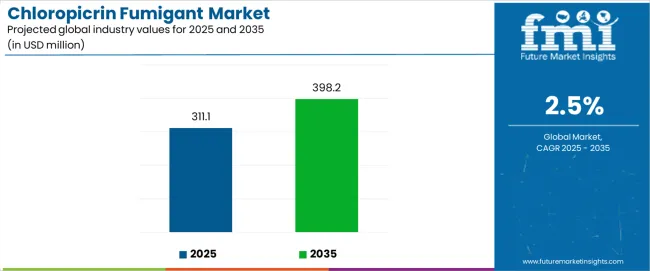
Between 2025 and 2030, the chloropicrin fumigant market is projected to expand from USD 311.1 million to USD 351.9 million, resulting in a value increase of USD 40.8 million, which represents 46.9% of the total forecast growth for the decade. This phase of development will be shaped by increasing demand for precision agricultural practices, rising global food production requirements enabling advanced soil treatment techniques, and growing availability of regulated fumigation technologies across commercial farming operations and specialty crop facilities.
Between 2030 and 2035, the chloropicrin fumigant market is forecast to grow from USD 351.9 million to USD 398.2 million, adding another USD 46.3 million, which constitutes 53.1% of the overall ten-year expansion. This period is expected to be characterized by the advancement of application monitoring systems, the integration of precision dosing equipment for treatment optimization, and the development of enhanced formulation technologies across diverse agricultural applications. The growing emphasis on food security and crop yield optimization will drive demand for advanced fumigant varieties with enhanced efficacy profiles, improved application safety characteristics, and superior environmental compatibility features.
Between 2020 and 2024, the chloropicrin fumigant market experienced moderate growth, driven by increasing agricultural intensification and growing recognition of chloropicrin's effectiveness in delivering comprehensive soil sterilization across horticultural and specialty crop applications. The chloropicrin fumigant market developed as growers recognized the potential for advanced fumigation to deliver crop protection benefits while meeting modern requirements for pest management and high-value agricultural production. Technological advancement in application equipment and formulation chemistry began emphasizing the critical importance of maintaining treatment efficacy while enhancing operator safety and improving environmental stewardship practices.
| Metric | Value |
|---|---|
| Estimated Value in (2025E) | USD 311.1 million |
| Forecast Value in (2035F) | USD 398.2 million |
| Forecast CAGR (2025 to 2035) | 2.5% |
From 2030 to 2035, the chloropicrin fumigant market is forecast to grow from USD 351.9 million to USD 398.2 million, adding another USD 46.3 million, which constitutes 53.1% of the overall ten-year expansion. This period is expected to be characterized by the advancement of integrated pest management protocols, the integration of precision application systems for treatment efficiency, and the development of specialized formulation configurations for enhanced soil penetration patterns. The growing emphasis on crop quality optimization and production reliability will drive demand for premium varieties with enhanced biological activity credentials, improved application consistency options, and superior performance characteristics.
Between 2020 and 2024, the chloropicrin fumigant market experienced steady growth, driven by increasing awareness of soil health benefits and growing recognition of fumigation systems' effectiveness in supporting efficient crop production across agricultural operations and specialty growing facilities. The chloropicrin fumigant market developed as users recognized the potential for specialized fumigants to deliver productivity advantages while meeting modern requirements for consistent crop establishment and reliable pest control performance. Technological advancement in formulation processes and application systems began emphasizing the critical importance of maintaining treatment standards while extending product efficacy and improving grower satisfaction across diverse agricultural applications.
Market expansion is being supported by the increasing global demand for effective soil treatment solutions and the corresponding shift toward high-performance fumigants that can provide superior biological activity characteristics while meeting user requirements for crop protection reliability and cost-effective pest management processes. Modern agricultural operators are increasingly focused on incorporating fumigation systems that can enhance productivity while satisfying demands for consistent, precisely controlled soil sterilization and optimized crop establishment practices. Chloropicrin fumigant's proven ability to deliver biological efficacy, soil health protection, and diverse application possibilities makes it an essential component for agricultural producers and quality-conscious crop protection professionals.
The growing emphasis on precision agriculture and crop optimization is driving demand for high-performance fumigation systems that can support distinctive agricultural outcomes and comprehensive soil management across field crops, specialty horticulture, and greenhouse production applications. User preference for fumigants that combine functional excellence with application flexibility is creating opportunities for innovative implementations in both traditional and emerging agricultural applications. The rising influence of integrated pest management practices and advanced agricultural technologies is also contributing to increased adoption of specialized fumigants that can provide authentic performance benefits and reliable biological characteristics.
The chloropicrin fumigant market is segmented by purity level, application, formulation type, delivery method, and region. By purity level, the chloropicrin fumigant market is divided into purity <99.5%, purity ≥99.5%, technical grade, analytical grade, and pharmaceutical grade. Based on application, the chloropicrin fumigant market is categorized into soil fumigation, food storage protection, wood treatment, structural fumigation, and others. By formulation type, the market includes liquid concentrate, emulsifiable concentrate, granular formulation, and aerosol systems. By delivery method, the chloropicrin fumigant market encompasses soil injection, surface application, enclosed space fumigation, and specialized delivery systems. Regionally, the market is divided into North America, Europe, Asia Pacific, Latin America, Middle East & Africa, and other regions.
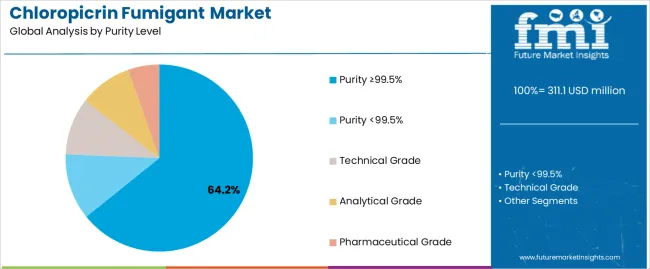
The purity ≥99.5% segment is projected to account for 64.2% of the chloropicrin fumigant market in 2025, reaffirming its position as the leading purity category. Agricultural professionals and crop protection specialists increasingly utilize high-purity chloropicrin for its superior biological activity characteristics, established efficacy standards, and essential functionality in diverse agricultural applications across multiple crop types. High-purity chloropicrin's proven performance characteristics and established cost-effectiveness directly address user requirements for reliable pest control operation and optimal crop protection precision in commercial applications.
This purity segment forms the foundation of modern agricultural fumigation patterns, as it represents the grade category with the greatest biological impact potential and established compatibility across multiple application systems. Business investments in advanced purification technology and quality optimization continue to strengthen adoption among efficiency-conscious growers. With users prioritizing treatment consistency and biological reliability, high-purity chloropicrin aligns with both productivity objectives and regulatory requirements, making it the central component of comprehensive crop protection strategies.
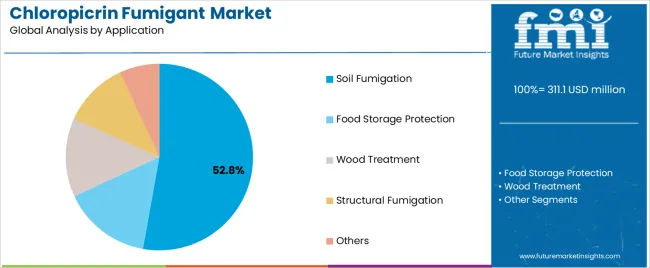
Soil fumigation is projected to represent 52.8% of the chloropicrin fumigant market in 2025, underscoring its critical role as the primary application for quality-focused growers seeking superior pest control efficiency benefits and enhanced crop establishment credentials. Commercial producers and agricultural professionals prefer soil applications for their established treatment volumes, proven market demand, and ability to maintain exceptional soil sterilization while supporting versatile crop requirements during diverse growing operations. Positioned as essential applications for performance-conscious agricultural operators, soil fumigation offerings provide both operational excellence and competitive positioning advantages.
The segment is supported by continuous improvement in application technology and the widespread availability of established treatment protocols that enable quality assurance and premium positioning at the grower level. Additionally, agricultural companies are optimizing fumigant selections to support crop differentiation and competitive production strategies. As fumigation technology continues to advance and growers seek efficient treatment methods, soil applications will continue to drive market growth while supporting business development and crop protection strategies.
The chloropicrin fumigant market is advancing steadily due to increasing agricultural efficiency consciousness and growing need for precision pest management solutions that emphasize superior biological outcomes across agricultural segments and specialty crop applications. However, the chloropicrin fumigantmarket faces challenges, including regulatory restrictions on fumigant usage, environmental safety concerns, and application cost pressures affecting operational economics. Innovation in precision application integration and enhanced formulation technologies continues to influence market development and expansion patterns.
The growing adoption of chloropicrin fumigant in specialty crop production and high-value agricultural development is enabling growers to develop pest management strategies that provide distinctive efficacy benefits while commanding competitive positioning and enhanced crop quality characteristics. Specialty applications provide superior biological consistency while allowing more sophisticated treatment control features across various crop categories. Users are increasingly recognizing the operational advantages of fumigant positioning for premium crop outcomes and efficiency-conscious agricultural integration.
Modern chloropicrin fumigant manufacturers are incorporating advanced application technologies, precision dosing control systems, and real-time monitoring tracking to enhance treatment precision, improve application safety, and meet commercial demands for intelligent pest management solutions. These systems improve operational effectiveness while enabling new applications, including integrated pest management programs and treatment optimization protocols. Advanced application integration also allows growers to support productivity leadership positioning and crop protection assurance beyond traditional fumigation operations.
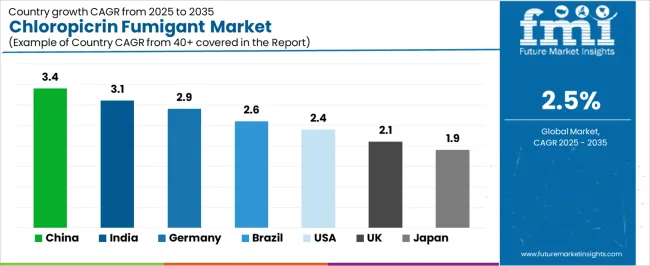
| Country | CAGR (2025-2035) |
|---|---|
| China | 3.4% |
| India | 3.1% |
| Germany | 2.9% |
| Brazil | 2.6% |
| USA | 2.4% |
| UK | 2.1% |
| Japan | 1.9% |
The chloropicrin fumigant market is experiencing steady growth globally, with China leading at a 3.4% CAGR through 2035, driven by the expanding agricultural sector, growing specialty crop production requirements, and increasing adoption of intensive farming systems. India follows at 3.1%, supported by rising food production demands, expanding horticultural sector, and growing acceptance of advanced pest management solutions. Germany shows growth at 2.9%, emphasizing established agricultural capabilities and comprehensive crop protection technology development. Brazil records 2.6%, focusing on agricultural expansion and specialty crop production growth. The USA demonstrates 2.4% growth, prioritizing advanced fumigation technologies and application optimization.
The report covers an in-depth analysis of 40+ countries, the top-performing countries are highlighted below.
Revenue from chloropicrin fumigant consumption and sales in China is projected to exhibit strong growth with a CAGR of 3.4% through 2035, driven by the country's rapidly modernizing agricultural sector, favorable government policies toward food security enhancement, and initiatives promoting advanced pest management technologies across major agricultural regions. China's position as a leading agricultural producer and increasing focus on crop yield optimization are creating substantial demand for high-quality chloropicrin fumigant in both domestic food production and export crop markets. Major agricultural companies and specialty crop producers are establishing comprehensive fumigation capabilities to serve growing demand and emerging market opportunities.
Revenue from chloropicrin fumigant products in India is expanding at a CAGR of 3.1%, supported by rising food production investment, growing agricultural development, and expanding crop protection capabilities. The country's developing agricultural sector and increasing commercial investment in advanced pest management technologies are driving demand for chloropicrin fumigant across both traditional and modern agricultural applications. International fumigant companies and domestic distributors are establishing comprehensive operational networks to address growing market demand for quality fumigation and efficient pest control solutions.
Revenue from chloropicrin fumigant products in Germany is projected to grow at a CAGR of 2.9% through 2035, supported by the country's mature agricultural sector, established crop protection standards, and leadership in fumigation technology. Germany's sophisticated agricultural infrastructure and strong support for advanced pest management systems are creating steady demand for both traditional and innovative fumigant varieties. Leading agricultural companies and specialty distributors are establishing comprehensive operational strategies to serve both domestic markets and growing export opportunities.
Revenue from chloropicrin fumigant products in Brazil is projected to grow at a CAGR of 2.6% through 2035, driven by the country's emphasis on agricultural expansion, crop production development, and growing fumigation capabilities. Brazilian producers and agricultural companies consistently seek commercial-grade fumigants that enhance crop efficiency and support operational excellence for both traditional and modern agricultural applications. The country's position as a Latin American agricultural leader continues to drive innovation in specialized fumigation applications and commercial pest management standards.
Revenue from chloropicrin fumigant products in the USA is projected to grow at a CAGR of 2.4% through 2035, supported by the country's emphasis on agricultural technology advancement, crop optimization, and advanced application integration requiring efficient fumigation solutions. American producers and agricultural users prioritize treatment reliability and operational precision, making specialized fumigants essential components for both traditional and modern agricultural applications. The country's comprehensive technology leadership and advancing agricultural patterns support continued market expansion.
Revenue from chloropicrin fumigant products in the UK is projected to grow at a CAGR of 2.1% through 2035, supported by established agricultural standards, mature producer markets, and emphasis on crop protection reliability across commercial and specialty sectors. British producers and agricultural professionals prioritize quality performance and operational consistency, creating steady demand for premium fumigation solutions. The country's comprehensive market maturity and established agricultural practices support continued development in specialized applications.
Revenue from chloropicrin fumigant products in Japan is projected to grow at a CAGR of 1.9% through 2035, supported by the country's emphasis on precision agriculture, quality excellence, and advanced technology integration requiring efficient fumigation solutions. Japanese businesses and agricultural users prioritize technical performance and production precision, making specialized fumigants essential components for both traditional and modern agricultural applications. The country's comprehensive quality leadership and advancing agricultural patterns support continued market expansion.
The Europe chloropicrin fumigant market is projected to grow from USD 89.2 million in 2025 to USD 114.8 million by 2035, recording a CAGR of 2.6% over the forecast period. Germany leads the region with a 42.1% share in 2025, moderating slightly to 41.8% by 2035, supported by its strong agricultural base and demand for premium, technically advanced fumigation solutions. The United Kingdom follows with 18.7% in 2025, easing to 18.4% by 2035, driven by a mature agricultural market and emphasis on crop protection reliability and production optimization.
France accounts for 14.3% in 2025, rising to 14.6% by 2035, reflecting steady adoption of specialized crop protection solutions and agricultural efficiency enhancement. Italy holds 11.2% in 2025, expanding to 11.8% by 2035 as specialty crop production and horticultural applications grow. Spain contributes 8.1% in 2025, growing to 8.4% by 2035, supported by expanding agricultural sector and crop protection modernization. The Nordic countries rise from 3.8% in 2025 to 3.9% by 2035 on the back of advanced agricultural methodologies and precision farming adoption. BENELUX remains at 1.8% share across both 2025 and 2035, reflecting mature, efficiency-focused agricultural markets.
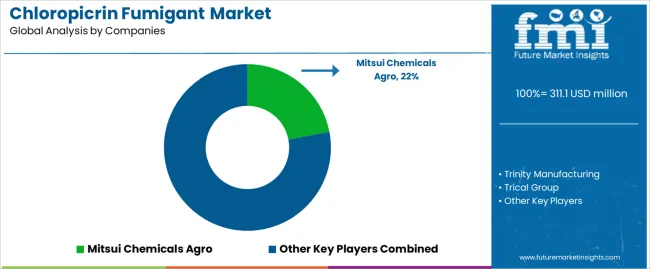 p>The chloropicrin fumigant market is characterized by competition among established chemical manufacturers, specialized fumigant producers, and integrated crop protection companies. Companies are investing in advanced purification technologies, enhanced formulation development systems, product innovation capabilities, and comprehensive distribution networks to deliver consistent, high-quality, and reliable chloropicrin fumigant systems. Innovation in efficacy enhancement, application optimization, and crop-specific product development is central to strengthening market position and customer satisfaction.
p>The chloropicrin fumigant market is characterized by competition among established chemical manufacturers, specialized fumigant producers, and integrated crop protection companies. Companies are investing in advanced purification technologies, enhanced formulation development systems, product innovation capabilities, and comprehensive distribution networks to deliver consistent, high-quality, and reliable chloropicrin fumigant systems. Innovation in efficacy enhancement, application optimization, and crop-specific product development is central to strengthening market position and customer satisfaction.
Mitsui Chemicals Agro leads the chloropicrin fumigantmarket with a strong focus on agricultural chemistry innovation and comprehensive chloropicrin fumigant solutions, offering commercial formulation systems with emphasis on manufacturing excellence and technological heritage. Trinity Manufacturing provides specialized fumigation products with a focus on agricultural market applications and performance engineering networks. Trical Group delivers integrated pest management solutions with a focus on grower positioning and operational efficiency. Ineos specializes in comprehensive chemical manufacturing with an emphasis on industrial applications. Dow AgroSciences focuses on comprehensive agricultural chemicals with advanced formulation and premium positioning capabilities.
The success of chloropicrin fumigant in meeting commercial agricultural demands, producer-driven efficiency requirements, and crop protection integration will not only enhance agricultural productivity outcomes but also strengthen global food security capabilities. It will consolidate emerging regions' positions as hubs for efficient agricultural production and align advanced economies with commercial farming systems. This calls for a concerted effort by all stakeholders -- governments, industry bodies, manufacturers, distributors, and investors. Each can be a crucial enabler in preparing the chloropicrin fumigant market for its next phase of growth.
How Governments Could Spur Local Production and Adoption?
How Industry Bodies Could Support Market Development?
How Distributors and Agricultural Industry Players Could Strengthen the Ecosystem?
How Manufacturers Could Navigate the Shift?
| Items | Values |
|---|---|
| Quantitative Units (2025) | USD 311.1 million |
| Purity Level | Purity <99.5%, Purity ≥99.5%, Technical Grade, Analytical Grade, Pharmaceutical Grade |
| Application | Soil Fumigation, Food Storage Protection, Wood Treatment, Structural Fumigation, Others |
| Formulation Type | Liquid Concentrate, Emulsifiable Concentrate, Granular Formulation, Aerosol Systems |
| Delivery Method | Soil Injection, Surface Application, Enclosed Space Fumigation, Specialized Delivery Systems |
| Regions Covered | North America, Europe, Asia Pacific, Latin America, Middle East & Africa, Other Regions |
| Countries Covered | China, India, Germany, Brazil, United States, United Kingdom, Japan, and 40+ countries |
| Key Companies Profiled | Mitsui Chemicals Agro, Trinity Manufacturing, Trical Group, Ineos, Dow AgroSciences, and other leading chloropicrin fumigant companies |
| Additional Attributes | Dollar sales by purity level, application, formulation type, delivery method, and region; regional demand trends, competitive landscape, technological advancements in fumigation engineering, precision application initiatives, efficacy enhancement programs, and premium product development strategies |
The global chloropicrin fumigant market is estimated to be valued at USD 311.1 million in 2025.
The market size for the chloropicrin fumigant market is projected to reach USD 398.2 million by 2035.
The chloropicrin fumigant market is expected to grow at a 2.5% CAGR between 2025 and 2035.
The key product types in chloropicrin fumigant market are purity ≥99.5%, purity <99.5%, technical grade, analytical grade and pharmaceutical grade.
In terms of application, soil fumigation segment to command 52.8% share in the chloropicrin fumigant market in 2025.






Full Research Suite comprises of:
Market outlook & trends analysis
Interviews & case studies
Strategic recommendations
Vendor profiles & capabilities analysis
5-year forecasts
8 regions and 60+ country-level data splits
Market segment data splits
12 months of continuous data updates
DELIVERED AS:
PDF EXCEL ONLINE
Agricultural Fumigant Market Size and Share Forecast Outlook 2025 to 2035

Thank you!
You will receive an email from our Business Development Manager. Please be sure to check your SPAM/JUNK folder too.
Chat With
MaRIA